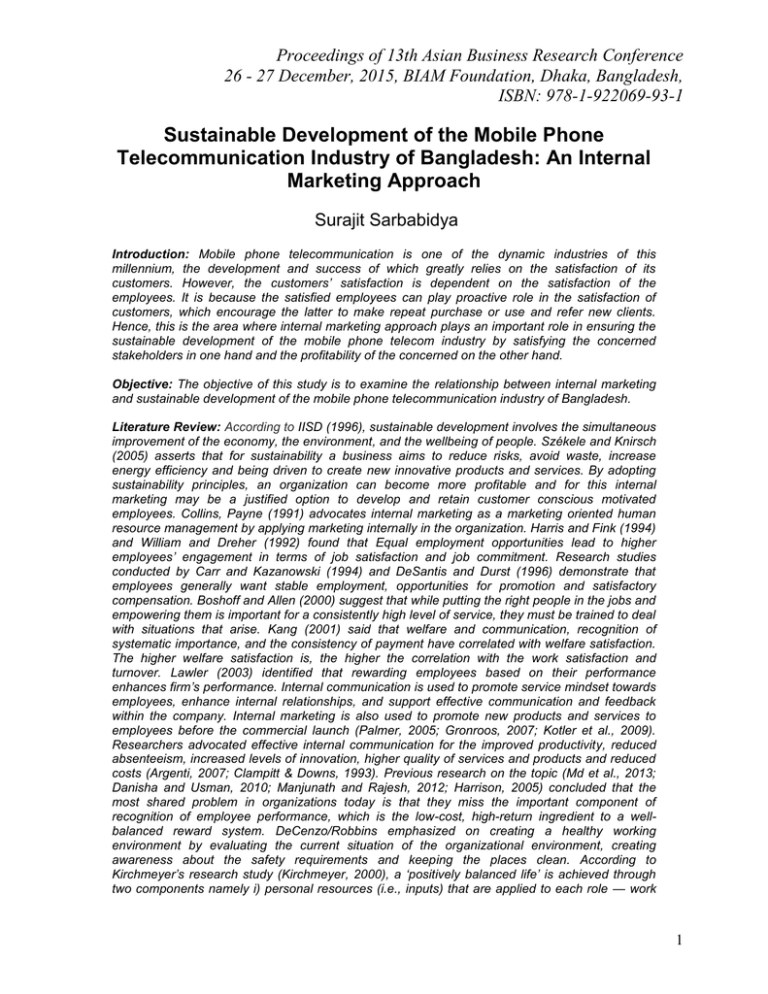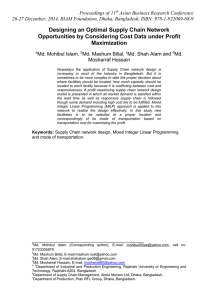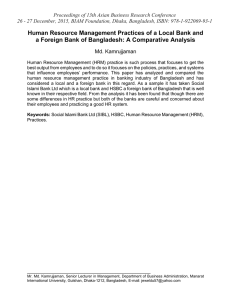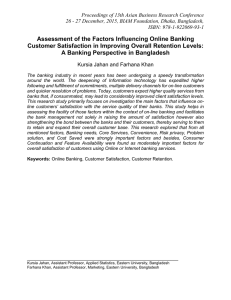
Proceedings of 13th Asian Business Research Conference
26 - 27 December, 2015, BIAM Foundation, Dhaka, Bangladesh,
ISBN: 978-1-922069-93-1
Sustainable Development of the Mobile Phone
Telecommunication Industry of Bangladesh: An Internal
Marketing Approach
Surajit Sarbabidya
Introduction: Mobile phone telecommunication is one of the dynamic industries of this
millennium, the development and success of which greatly relies on the satisfaction of its
customers. However, the customers’ satisfaction is dependent on the satisfaction of the
employees. It is because the satisfied employees can play proactive role in the satisfaction of
customers, which encourage the latter to make repeat purchase or use and refer new clients.
Hence, this is the area where internal marketing approach plays an important role in ensuring the
sustainable development of the mobile phone telecom industry by satisfying the concerned
stakeholders in one hand and the profitability of the concerned on the other hand.
Objective: The objective of this study is to examine the relationship between internal marketing
and sustainable development of the mobile phone telecommunication industry of Bangladesh.
Literature Review: According to IISD (1996), sustainable development involves the simultaneous
improvement of the economy, the environment, and the wellbeing of people. Székele and Knirsch
(2005) asserts that for sustainability a business aims to reduce risks, avoid waste, increase
energy efficiency and being driven to create new innovative products and services. By adopting
sustainability principles, an organization can become more profitable and for this internal
marketing may be a justified option to develop and retain customer conscious motivated
employees. Collins, Payne (1991) advocates internal marketing as a marketing oriented human
resource management by applying marketing internally in the organization. Harris and Fink (1994)
and William and Dreher (1992) found that Equal employment opportunities lead to higher
employees’ engagement in terms of job satisfaction and job commitment. Research studies
conducted by Carr and Kazanowski (1994) and DeSantis and Durst (1996) demonstrate that
employees generally want stable employment, opportunities for promotion and satisfactory
compensation. Boshoff and Allen (2000) suggest that while putting the right people in the jobs and
empowering them is important for a consistently high level of service, they must be trained to deal
with situations that arise. Kang (2001) said that welfare and communication, recognition of
systematic importance, and the consistency of payment have correlated with welfare satisfaction.
The higher welfare satisfaction is, the higher the correlation with the work satisfaction and
turnover. Lawler (2003) identified that rewarding employees based on their performance
enhances firm’s performance. Internal communication is used to promote service mindset towards
employees, enhance internal relationships, and support effective communication and feedback
within the company. Internal marketing is also used to promote new products and services to
employees before the commercial launch (Palmer, 2005; Gronroos, 2007; Kotler et al., 2009).
Researchers advocated effective internal communication for the improved productivity, reduced
absenteeism, increased levels of innovation, higher quality of services and products and reduced
costs (Argenti, 2007; Clampitt & Downs, 1993). Previous research on the topic (Md et al., 2013;
Danisha and Usman, 2010; Manjunath and Rajesh, 2012; Harrison, 2005) concluded that the
most shared problem in organizations today is that they miss the important component of
recognition of employee performance, which is the low-cost, high-return ingredient to a wellbalanced reward system. DeCenzo/Robbins emphasized on creating a healthy working
environment by evaluating the current situation of the organizational environment, creating
awareness about the safety requirements and keeping the places clean. According to
Kirchmeyer’s research study (Kirchmeyer, 2000), a ‘positively balanced life’ is achieved through
two components namely i) personal resources (i.e., inputs) that are applied to each role — work
1
Proceedings of 13th Asian Business Research Conference
26 - 27 December, 2015, BIAM Foundation, Dhaka, Bangladesh,
ISBN: 978-1-922069-93-1
and family — with an equally high level of attention, time, involvement, or commitment and ii)
equally high level of satisfaction with work and family roles (i.e., outcomes). In addition,
Kirchmeyer further associated balanced satisfaction across work and family roles with a high
quality of life. Hermansson (2003) advised recreational events to motivate employees, form a
binding spirit between new employees, find new arenas for all employees in which they can
validate themselves, present a new boss or manager, or simply to have great fun. Dalton & Croft
(2003) found the defined duties and responsibilities of employees for their effective contribution.
Previous researchers have found that participative management encourages the employees to act
more positively about their jobs (Anastassova and Purcell, 1995; Chow et al., 2006; Yoon and
Suh, 2003). In some studies it was found that logistic support are supportive management, and
service technology support (Lytle et al., 1998; Singh, 2000) where supportive management refers
to the willingness of the managers to go to bat for their subordinates (Babin and Boles, 1996; Bell
et al., 2004) and service technology support encompasses sophisticated and integrated tools
provided by management to employees to free them from routine tasks so that they can devote
more time to customers (Lytle et al., 1998). As part of positive interpersonal relationship, senior
managers, middle managers and employees’ expert peers all influence employee behaviour
(Lam, et al., 2010; Wieseke, et al., 2009).
Methodology: This study is the embodiment of the collection of primary and secondary data
collection and their analysis. For the purpose of collecting primary data random sampling method
has been adopted on a sample size of 123 employees of six mobile phone telecom service
providing companies in Bangladesh through an extensive survey. A structured self-administered
questionnaire using a 5-point Likert scale (1 = strongly disagree, 5 = strongly agree) has been
used for the survey. On the other hand, the secondary data have been collected through
extensive literature review on the articles and research papers published in the referred journals.
The study has been endeavored through quantitative analysis and as a part of this, the popular
statistical tools of reliability and validity measurements, factor analysis, correlations and multiple
regression analysis, etc., has/have been utilized to identify the relationship of the relationship
marketing components and their role in the sustainable development of the concerned industry.
Findings: It has been found from the study that internal marketing plays important role in the
sustainable development of the mobile phone telecommunication industry of Bangladesh through
the fruitful contribution of the motivated resourceful employees. The study also found that various
motivational measures for the employees including welfare, training, performance based pay,
recognition and appreciation, promotion, good workplace, work/life balance, recreation facilities,
equal employment opportunity, logistic support, etc., have contributed behind such development.
Conclusion/Implications: Finally, it can be stated that the study will enable the mobile
telecommunication operators to acquire, develop and retain the resourceful employees through
various incentives to utilize them to work for the sustainable development of the industry.
Keywords: Internal Marketing, Employee Motivation, Sustainable Development,
Mobile Phone Telecom Industry, etc.
________________________________________________________________
Dr. Surajit Sarbabidya, Associate Professor, School of Business, Britannia University, Comilla, Bangladesh.
Email:surajitsarbabidya@gmail.com Cell: 0088-01714409084
2
Proceedings of 13th Asian Business Research Conference
26 - 27 December, 2015, BIAM Foundation, Dhaka, Bangladesh,
ISBN: 978-1-922069-93-1
References
Anastassova, L., Purcell, K. (1995) Human resource management in the Bulgarian hotel
industry: from command to empowerment? International Journal of Hospitality
Management, Volume 14 (2), pp. 171–185.
Argenti, P. (2007) Corporate Communication. 4th edition, NY: McGraw-Hill.
Babin, B.J. and Boles, J.S. (1996) The effects of perceived co-worker involvement and
supervisor support on service provider role stress, performance and job satisfaction,
Journal of Retailing, Vol. 72, No. 1, pp. 57-77
Bell, S.J., Menguc, B. and Stefani, S.L. (2004) When customers disappoint: a model of
relational internal marketing and customer complaints. Journal of the Academy of
Marketing Science, Vol. 32, No. 2, pp. 112-26
Boshoff, C. and Allen, J. (2000) The influence of selected antecedents on frontline staff’s
perceptions of service recovery performance. International Journal of Service Industry
Management, Vol. 11, No. 1, pp. 63-90
Carr, K. K and M.S Kazanowski (1994) Factors Affecting Job Satisfaction of Nurses who
Work in Long Term Care. Journal of Adv Nuts, Vol. 19, pp. 878-883
Chow, I.H.S., Lo, T.W.C., Sha, Z., Hong, J. (2006) The impact of developmental
experience, empowerment, and organizational support on catering service staff
performance. Hospitality Management, Volume 25 (3), pp. 478–495
Clampitt, P., & Downs, C. (1993) Employee Perceptions of the Relationship Between
Communication and Productivity: A Field Study. Journal of Business Communication,
Volume 30 (1), pp. 5-28
Collins, B. & Payne, A. (1991) Internal marketing: a new perspective for HRM. European
Management Journal, Volume 9(3), pp. 261-270
Danish, R. Q., & Usman A. (2010) Impact of Reward and Recognition on Job Satisfaction
and Motivation: An Empirical Study from Pakistan. International Journal of Business
Management, Volume 5(2)
Dalton, J., Croft, S. (2003) Managing Corporate Reputation, Thorogood, London
DeCenzo D., & Robbins, S. (2005) Fundamentals of human resource management. 8th
Edition. John Wiley and Sons, 10th edition
3
Proceedings of 13th Asian Business Research Conference
26 - 27 December, 2015, BIAM Foundation, Dhaka, Bangladesh,
ISBN: 978-1-922069-93-1
DeSantis, V. S., and Durst, S. L. (1996) Comparing job satisfaction among public and
private sector employees. American Review of Public Administration, Volume 26(3), pp.
327-343
Gronroos, C. (2007) Service Management and Marketing, Customer Management in
Service Competition. John Wiley & Sons Ltd., England.
Harrison, K. (2005) Why Employee Recognition
www.cuttingedgepr.com (Accessed September 20, 2013)
is
so
Important,
[Online]
Harris, M.H and L.S Fink (1994) Employee Benefit Programs and Attitudinal and
Behavioral Outcomes: A Preliminary Model, Human Resource Management Review, Vol.
4, No. 2, pp. 117-129.
Hermansson, Anna (2003) at Wettergren & Co, Interview, 24th of October.
Kang, Y.C. (2001) A study of internal marketing, behavior-based evaluation, job
satisfaction, and customer oriented behaviors -- An example of securities salesmen.
Department of Business Management of National Sun Yat-Sen University, thesis,
unpublished: Kaohsiung
Kirchmeyer, C. (2000) Work-life initiatives: Greed or benevolence regarding workers_
time. In C. L. Cooper & D. M. Rousseau (Eds.), Trends in organizational behavior (Vol. 7,
pp. 79–93). West Sussex, UK: Wiley
Kotler & Keller (2009-10) Marketing Management. 13th Edition, New Jersey: Pearson
Prentice Hall, pp. 19-20
Lam, S. K., Kraus, F., & Ahearne, M. (2010) The Diffusion of Market Orientation
Throughout the Organization: A Social Learning Theory Perspective. Journal of
Marketing, Volume 74, No. 5, pp. 61-79
Lawler, E. E. (2003) Treat people right. San Francisco: Jossey-Bass Inc. McGrawHill Irwin.
Lytle, R.S., Hom, P.W. and Mokwa, M.P. (1998) SERV*OR: a managerial measure of
organizational service-orientation. Journal of Retailing, Vol. 74, No. 4, pp. 455-89
Manjunath, V.S. & Rajesh, C.N. (2012) Competency Based Compensation System- As a
Strategic Human Resource Technique. International Journal of Manpower, Volume 38,
No. 7, pp. 780-810
Md, S. A., Al, S. A. S., Md. S. & Akter. S. (2013) Relationship between Employee
Recognition and Employee Contribution in Service Industry. International Journal of
4
Proceedings of 13th Asian Business Research Conference
26 - 27 December, 2015, BIAM Foundation, Dhaka, Bangladesh,
ISBN: 978-1-922069-93-1
Business
and
Marketing
Management,
Vol.
1,
No.
1,
pp.
1-8
Palmer, A. (2005) Principles of Service Marketing. 4th Edition. McGraw Hill Education.
Belkshire. UK.
Singh, J. (2000) Performance productivity and quality of frontline employees in service
organizations. Journal of Marketing, Vol. 64, No. 2, pp. 15-34
Wieseke, J., Ahearne, M., Lam, S. K., & Dick, R. v. (2009) The Role of Leaders in Internal
Marketing. Journal of Marketing, Volume 73, No. 2, pp. 123-145
William, M and G Dreher (1992) Compensation System Attributes and Applicant Pool
Characteristics. Academy of Management Journal, Vol. 35, pp. 571-595
Yoon, M.H., Suh, J. (2003) Organizational citizenship behaviors and service quality as
external effectiveness of contact employees. Journal of Business Research, Volume 56,
pp. 597–611
5





